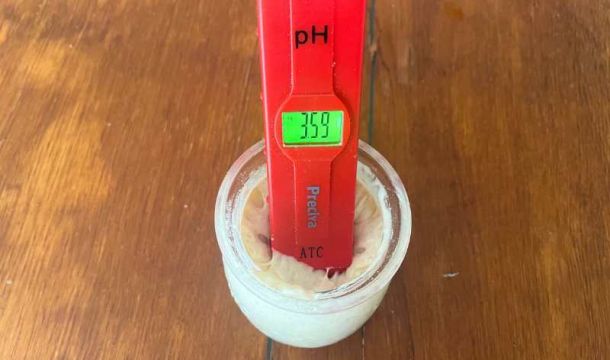
How To Store Bread (And the science behind it!)

Not everyone can finish their freshly baked bread on the same day of baking which is why how you store bread plays such an important role. Bread shouldn’t just sit on a table or chopping board! So, what should you do to make sure your bread stays fresh? This post will help you store bread correctly to prevent staleness, mould, and bacteria!
There are many ways to store homemade bread. Using a large tea towel or cotton sack to wrap it is most bakers preferred option. But a bread box is also a great method, especially if you’re in an area that’s humid. If you’re needing to store your bread for a long period, storing it in the freezer is the best solution.
Why does bread go stale?
Staling sets as soon as the bread cools down. Once a loaf exits the oven, bread loses its freshness. This is because of two main factors: moisture movement and starch retrogradation.
Moisture movement
The tendency of moisture in bread is to move from a concentrated area to an area with less concentration. Since the centre of the bread is more concentrated, the moisture moves towards the crust. This process is also known as water migration.
Ideally, the bread should remain soft and flexible while fresh. But while it’s cooling down, the humidity in the environment changes. This leads the moisture to evaporate and move out of the bread, which causes bread to become dry, crumble, and stale.
Starch retrogradation
As the loss of moisture makes the bread stale, starch retrogradation plays a bigger factor. All types of flour contain high amounts of starch, and it comes in a highly organized structure form of crystalline. As water is added to flour, the starch molecules gelatinize and become disorganized. This gives the bread a soft and fluffy texture when we take it out of the oven.
Now, as the bread cools down, the process reverses. The starch molecules will start to solidify back together and regain their organized state. This will then cause the bread to become stale.

The LuvURkitchen extra large wooden bread box on Amazon
Starch retrogradation vs moisture loss
Even if both processes contribute to the staleness of bread, they still differ from each other. As the bread loses its moisture, it causes dryness to the texture. While retrogradation recrystallizes the structure of starch molecules, which makes the bread hard. This is why starch retrogradation contributes more to what is often referred to as “staleness” than moisture loss.
How wrapping bread keeps it fresh
After cooling down, bread is usually wrapped with plastic or paper to prevent it from losing moisture. Wrapping the bread will trap the moisture and water molecules inside and stop them from evaporating. Also, since air can’t penetrate through sealed wraps, the bread is protected from absorbing water vapour in the environment. This will help in keeping the bread fresh while slowing down the dryness and staleness at the same time.
However, wrapping the bread for a long period isn’t usually advisable. Since the moisture is trapped inside, storing it wrapped for too long increases the risk of mould and bacteria to set in. The crust might also suffer from some problems as the extra water can turn it soggy if wrapped, or dry if there is more airflow. Toasting the bread, or reheating the loaf whole can bring back some of the crust’s original crunchy texture.
How to keep bread fresh for longer
Besides using plastic bags or wraps, there are a couple of tricks that you can do to keep your bread fresh for a longer period. Some of them are listed below:
Don’t slice it straight away
First and foremost, before consuming or storing your bread, you should not slice it right after taking it out of the oven. Slicing it without letting it cool will result in a heavy moisture loss. This will cause the bread to stale fast and lose its softness. Instead, let your bread cool down properly before slicing it. This will also make the bread easier to slice without it crumbling apart.
Once the bread is cool, again it’s best to slice when you need it as a larger surface area stales faster.
Cotton bag or tea towel
One of the best ways to keep your bread fresh longer is by wrapping it with a cotton bag or tea towel. Unlike a wrap, these two will still let the bread breathe while keeping the crust crispy. These also reduce the airflow so they can prevent the bread from drying out quickly.
Freeze your bread
If you’re not planning to consume your freshly baked bread for a couple of days or even weeks, freezing it is the best way to store it. Just use plastic wrap or foil and place it in a sealed bag before putting it in the freezer. If you’re going to consume the bread after freezing, let it thaw at room temperature first before heating it up again. You can also just freeze a couple of slices of bread so you don’t have to repeat the process again for leftovers.
As freezing is a great way of storing bread, doing it for an extremely long period will have its downsides. Freshness, taste, and texture will gradually decrease over time. This is why it’s best to use frozen bread within a couple of weeks or so.
Store your bread in a bread box
A bread box is a popular way of storing your bread, as it’s designed to keep bread fresh and crisp for a longer period. The bread box allows some airflow while reducing moisture loss and mould growth. The usual bread boxes are made of wood or bamboo and you’ll see that they’re not airtight. Using a bread box is ideal for those bakers who live in humid conditions.

You may wish to wrap bread and store it in a bread box for the best of both methods.
Can I refrigerate bread?
No! Using the fridge to store your bread is actually a bad idea. Doing so will increase the moisture, which can result in mould and bacteria growth. Starch molecules will also reform faster when you’re refrigerating bread. So, staleness will happen more quickly.
The only exception for refrigerating your bread is when the temperature and humidity in your place are extremely high. If this is the case, storing in the fridge is a lesser evil. However, using a bread box is usually much better.
Frequently asked questions about storing bread
If you’ve enjoyed this article and wish to treat me to a coffee, you can by following the link below – Thanks x

Hi, I’m Gareth Busby, a baking coach, head baker and bread-baking fanatic! My aim is to use science, techniques and 15 years of baking experience to help you become a better baker.
Table of Contents
Related Recipes
Related Articles
Keep up to date with the latest Articles, Recipes & Bread Baking info by joining my mailing list
Join The Weekly Bread Baker's Newsletter!
Latest Articles
Baking Categories
Disclaimer
Address
8 Woodland Avenue,
Worthing
West Sussex
BN13 3AF
UK








Leave a Reply